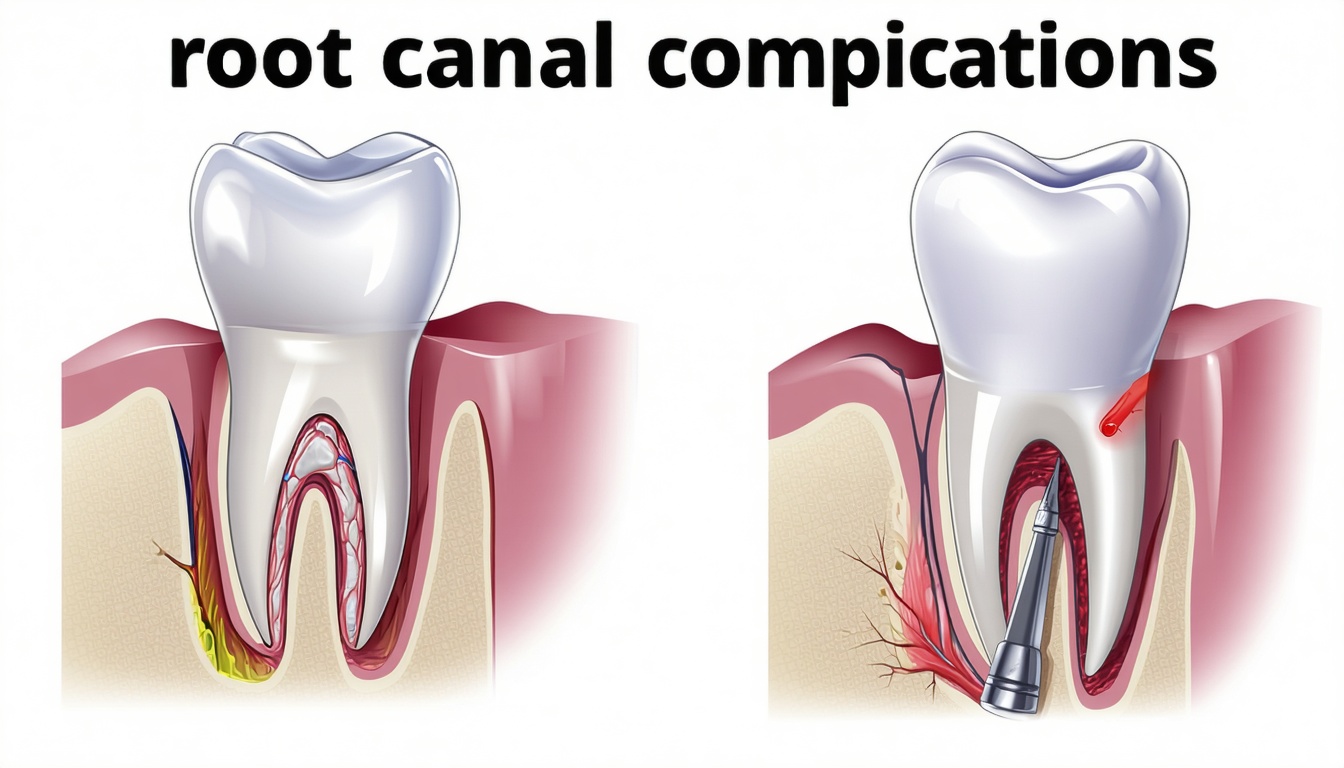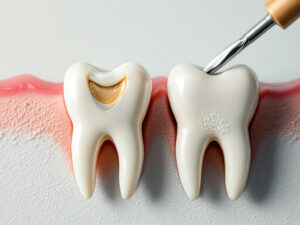Understanding Root Canal Treatment
In this section, you will learn about root canal treatment, including its success rates, causes of potential tooth discoloration, and the risk of sinus congestion associated with the procedure.
Success Rates of Root Canal Treatment
Root canal treatment has extremely high success rates, especially when performed by a skilled endodontist. The success rate often exceeds 95%, meaning that most patients experience relief from pain and preserve their natural teeth following the procedure. For more detailed information, check our article on root canal success rate.
Causes of Tooth Discoloration
Tooth discoloration can be a concern for some patients after a root canal. This issue may occur in a small percentage of cases following the removal of dental pulp, which can alter the tooth’s color. Factors such as age, the type of tooth, and the extent of the initial problem can influence the likelihood of this occurrence. If you’re interested in potential solutions for tooth discoloration, consider learning more about other options available through our root canal procedure steps guide.
| Potential Causes of Tooth Discoloration | Occurrence Rate |
|---|---|
| Removal of dental pulp | Small percentage of cases |
| Age | N/A |
| Type of tooth | N/A |
Potential Risk of Sinus Congestion
A root canal can also have complications that affect your sinuses. Due to the proximity of the root canal to the sinus cavity, you may experience sinus congestion or headaches. This symptom is generally temporary and resolves within a few weeks after the treatment. Understanding this risk is crucial for patients considering or recovering from a root canal, and it can help to have proper expectations about the healing process. For more insights on recovery, visit our article on root canal recovery time.
In summary, understanding root canal treatment involves knowing its high success rates, the potential for tooth discoloration, and the risks of sinus congestion. This knowledge empowers you to make informed decisions regarding your dental care and ensure a smoother recovery process. For any immediate concerns about symptoms or aftercare, refer to our resources on root canal pain relief tips and root canal home care aftercare.
Common Complications After Root Canal
Experiencing a root canal treatment can lead to various complications, which may impact your recovery. Understanding these potential issues can help you take proactive steps to ensure a successful outcome.
Risk of Reinfection
Reinfection is a prevalent concern following a root canal. This often occurs due to seal failure or inadequate sealing of the root canal, allowing bacteria to re-enter the tooth (Dental Perfections). If any step of the procedure is not performed correctly, such as overlooking narrow root canal branches, the risk of reinfection increases.
To minimize this risk, it is essential to choose a qualified endodontist and to follow proper aftercare instructions. If you notice symptoms like persistent pain or swelling, consult your dentist promptly to assess for possible reinfection.
Tooth Cracking Post-Procedure
Some patients may experience tooth cracking after root canal treatment. The process can make the tooth brittle, increasing the risk of fracture. This brittleness is a consequence of the tooth dying during the procedure, rendered vulnerable to external stresses (Dental Perfections).
Crowns are highly recommended to strengthen the tooth after a root canal. Installing a crown helps absorb chewing forces and protects the remaining tooth structure, diminishing the likelihood of cracks. If you are concerned about the integrity of your tooth post-treatment, discuss crown options with your dentist.
| Complication | Description | Recommendations |
|---|---|---|
| Reinfection | Bacteria re-enters the tooth due to seal failure | Ensure proper sealing and aftercare |
| Tooth Cracking | Brittle teeth may crack post-treatment | Consider a crown for added protection |
Tooth Infection Symptoms
Infection remains a possible complication post-root canal treatments. Infection can occur if bacteria enter the tooth and the surrounding soft tissue during the treatment or if there was an initial inadequacy in the root canal therapy. Signs that may indicate a tooth infection include:
- Persistent pain
- Fever
- Swelling
- Abscess or pus discharge
In such cases, antibiotics may be prescribed to tackle the infection. For more severe instances, retreatment or apical surgery may be necessary (East Coast Endodontics). If you suspect an infection, doing so can be critical in preserving your tooth and oral health.
Being aware of these potential complications allows you to better navigate your root canal recovery and engage in proactive discussions with your dental professional. For additional information on the steps of a root canal, see our page on root canal procedure steps.
Addressing Complications Post-Root Canal
Experiencing complications after a root canal can be concerning. It’s essential to understand how to address these issues effectively to ensure a smooth recovery. This section will explore numbness and nerve inflammation, the importance of timely crown placement, and options for fractured teeth.
Numbness and Nerve Inflammation
Numbness may occur after a root canal if the material used to fill the root canal moves outside its intended perimeter, causing inflammation in nearby nerves. This numbness can also result from nerve bumping, puncturing, or bruising during the procedure. A small percentage of patients may experience numbness in the surrounding nerves, which typically resolves within a few weeks (East Coast Endodontics, Dental Perfections).
If you experience prolonged numbness after your treatment, it is advisable to contact your endodontist immediately. Timely intervention can help prevent further issues and ensure proper healing.
| Potential Causes of Numbness | Description |
|---|---|
| Material Displacement | Filling material affects nearby nerves. |
| Nerve Bruising | Nerves are bumped or injured during the procedure. |
| Allergic Reactions | Reactions to anesthesia can occur. |
Importance of Timely Crown Placement
After a root canal, placing a crown on the treated tooth is vital. Delay in crown placement can lead to weakened teeth, increasing the risk of fractures and reinfection. A crown provides necessary protection for the tooth and restores its functionality. It also helps to maintain the alignment of adjacent teeth, preventing further complications.
It is generally recommended to have the crown placed within a few weeks after the root canal procedure for optimal protection. If you require more information on the timing for crowns, refer to our article on root canal recovery time.
Fractured Tooth Options
If your tooth has fractured post-root canal, there are several treatment options available. Depending on the severity of the fracture, your dentist may recommend one of the following:
| Fracture Severity | Treatment Options |
|---|---|
| Minor cracks | Bonding or repairing the tooth with dental adhesive. |
| Moderate fractures | Crowns to restore function and appearance. |
| Severe fractures | Extraction of the tooth may be necessary if it’s too damaged. |
It’s essential to consult with your dentist promptly if you suspect a fracture to explore the best treatment options and avoid further complications. For added information on the differences between root canal treatment and tooth extraction, check our article on root canal vs tooth extraction.
Dealing with Failed Root Canals
Experiencing complications after a root canal can be concerning. Understanding the signs of a failed root canal, how to diagnose it, and the treatment options available is essential for maintaining your dental health.
Symptoms of Failed Root Canal
Failed root canals occur when the original treatment does not entirely eliminate the infection, resulting in reinfection. Symptoms can vary but often include:
- Persistent Pain: Continuous discomfort that affects daily activities like eating and chewing.
- Tooth Discoloration: Changes in the color of the tooth.
- Pimples on Gums: Small, painful bumps may appear near the affected tooth.
- Swelling: Inflammation in the gums surrounding the tooth.
These symptoms may take weeks, months, or even years to surface, indicating the need for immediate consultation with a dental professional.
Diagnosing Failed Root Canals
Endodontists depend on dental X-rays to diagnose failed root canals. Since symptoms can be subtle, X-rays are a key tool in assessing:
- The dental pulp
- The periodontal ligament
- The bone surrounding the tooth
Identifying any issues will guide the dentist in determining if further treatment is necessary (Midtown Endodontist NYC).
| Diagnostic Tool | Purpose |
|---|---|
| X-ray | Examine dental pulp and surrounding areas for signs of infection or complications |
Treatment Options for Failed Root Canals
If a root canal has failed, there are several treatment options to consider:
- Root Canal Retreatment: This is the most commonly recommended solution and has the highest success rate. It involves accessing the tooth again to eliminate the residual infection and clean the canals thoroughly.
- Extraction: If retreatment is not viable, extraction may be necessary to prevent further complications or infection spread.
- Apicoectomy: This surgical procedure involves removing the tip of the tooth’s root to eliminate the infection. It is often considered when traditional retreatment is unsuccessful (Midtown Endodontist NYC).
Each treatment option comes with its considerations. It is advisable to discuss your specific symptoms with your dentist to find the best course of action. For more detailed insights on root canal procedures, visit our sections on what is root canal treatment and root canal vs tooth extraction.
Root Canal Therapy Side Effects
Experiencing side effects after a root canal is common. Understanding how to manage these issues effectively can aid in your recovery. Here are key areas to focus on regarding pain relief, swelling, inflammation, and infection risks after the procedure.
Pain Management Strategies
Following root canal therapy, pain and discomfort in the affected area can occur, usually described as mild to moderate. This discomfort is often due to inflammation and irritation of the surrounding tissues during the procedure. To manage this pain effectively, you can:
- Use Over-the-Counter Pain Relievers: Medications like ibuprofen or acetaminophen can help alleviate discomfort.
- Follow Post-Op Guidelines: Adhere to any specific instructions provided by your dentist for pain management.
For more detailed pain relief tactics, check our recommendations on root canal pain relief tips.
Managing Swelling and Inflammation
Swelling and inflammation often accompany root canal therapy as part of the body’s natural response to the procedure. To manage these symptoms, consider the following strategies:
| Strategy | Description |
|---|---|
| Cold Compress | Apply a cold pack to the affected area for 15-20 minutes to reduce swelling. |
| Anti-Inflammatory Medication | Use prescribed/over-the-counter medications to help reduce inflammation. |
| Saltwater Rinse | Rinsing your mouth with a warm saltwater solution can soothe irritation. |
| Elevate Your Head | Keeping your head elevated can help minimize swelling. |
For more extensive approaches to manage aftercare, refer to root canal home care aftercare.
Risk of Infection Post-Procedure
Despite the goal of root canal therapy being to eliminate infection, there remains a risk of reinfection. Factors that could lead to this include:
- Bacteria Left Behind: Incomplete cleaning during the procedure can allow bacteria to persist.
- Improper Sealing: If the tooth is not sealed correctly after treatment, bacteria can re-enter the tooth.
- Cracks or Fractures in the Tooth: Existing structural issues can also lead to infection.
To mitigate this risk, follow your dentist’s post-treatment care instructions carefully. For a deeper understanding of root canal procedures and potential issues, explore our article on what is root canal treatment.
By monitoring your recovery, communicating with your dentist, and employing these strategies, you can effectively navigate common side effects associated with root canal therapy.
Contributing Factors for Root Canals
Understanding the factors that lead to the need for a root canal is essential in preventing complications. Many individuals seek root canal treatment due to specific circumstances affecting their dental health. This section outlines the main contributing factors, including tooth decay, gum disease, and trauma.
Tooth Decay and Pulp Damage
Tooth decay is the most prevalent reason you may require a root canal. Cavities can inflict damage on the pulp and nerves within your tooth, ultimately resulting in pain and heightened sensitivity (Cascade Endodontics). If not addressed promptly, the decay can spread, making a root canal necessary to save the tooth.
| Stage of Tooth Decay | Description |
|---|---|
| Initial Decay | Minor cavities that can be filled. |
| Moderate Decay | Expanded cavities requiring extensive fillings. |
| Severe Decay | Leads to pulp damage and potential root canal. |
Gum Disease Implications
Gum disease can also necessitate a root canal due to its potential to cause deterioration of the tooth structure. Advanced gum disease can result in pulp infection, causing severe pain and necessitating treatment (Cascade Endodontics). Practicing strong oral hygiene habits is crucial for preventing gum disease and its complications.
| Gum Disease Stage | Description |
|---|---|
| Gingivitis | Inflammation of gums, usually reversible with proper care. |
| Periodontitis | Advanced inflammation leading to tooth structure deterioration. |
| Severe Periodontitis | Risk of pulp infection and potential root canal. |
Trauma and Tooth Injuries
Injuries to the tooth from sports or accidents can also lead to the necessity for a root canal. Trauma can cause the tooth pulp to become infected or inflamed, further leading to decay and requiring immediate attention (Cascade Endodontics). Timely intervention is vital to preserve the affected tooth.
| Type of Trauma | Resulting Risk |
|---|---|
| Sports Injury | Potential pulp inflammation or infection. |
| Fall or Accident | Increased risk of decay and root canal necessity. |
By being aware of these contributing factors, you can take steps to protect your dental health, thus minimizing the risk of needing a root canal. Familiarizing yourself with signs you need a root canal and seeking timely dental care can help you maintain a healthy smile.










